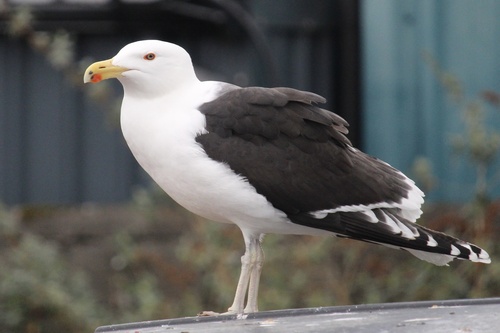
Great Black-backed Gull
The Great Black-backed Gull (*Larus marinus*) is the largest gull species in the world, a formidable and opportunistic seabird found along North Atlantic coasts. It plays a significant ecological role as both a predator and scavenger, influencing populations of other seabirds and intertidal organisms. While not globally threatened, its populations are subject to regional fluctuations due to changes in food availability and human activities. It's a bird easily recognized due to its size and dominance, often seen as a symbol of wild coastlines.
64-79 cm
Length
150-170 cm
Wingspan
Least Concern
Conservation Status
Distribution
Coasts of the North Atlantic Ocean. Breeds in North America from the Canadian Arctic south to the mid-Atlantic states, and in Europe from Iceland and Scandinavia south to France. Winters along both coasts, extending further south.
Lifespan
Typically 10-15 years in the wild, but some individuals have lived over 20 years.
Great Black-backed Gull's Habitat
Habitat Types
Rocky coastlines, Islands, Estuaries, Coastal marshes, Beaches
Climate Zones
Temperate, Subarctic, Arctic
Adaptations
Tolerant of cold temperatures and harsh weather conditions. Strong fliers capable of long-distance foraging trips. Adaptable to a wide range of food sources, allowing them to thrive in various coastal habitats.
Variations
Two subspecies are generally recognized, though differences are subtle. *Larus marinus marinus* in Europe, and *Larus marinus schistisagus* is found in North America.
Appearance
Breeding Plumage
Adults in breeding plumage have a white head, neck, and underparts, with a dark slate-gray to black back and wings. Non-breeding adults have some streaking on the head and neck.
Seasonal Feather Changes
Head becomes more streaked in winter, and the bill may develop a darker band.
Sex Based Plumage Differences
Minimal; males may have slightly brighter bill coloration.
Notable Features
Massive size, Heavy yellow bill with a red spot on the lower mandible, Dark back (slate-gray to black), Pink legs
Diet and Feeding
Primary Foods
Fish, Crustaceans, Mollusks, Eggs, Chicks of other birds, Carrion, Garbage
Foraging Behavior
Opportunistic feeders. They will catch fish near the surface, steal food from other birds (kleptoparasitism), scavenge on beaches, and patrol fishing boats. They also prey on smaller birds and their eggs.
Specializations
Powerful bill capable of crushing shells and tearing flesh. Can swallow surprisingly large prey whole.
Seasonal Diet Variations
Diet varies depending on food availability. May rely more on scavenging and garbage during winter months when other food sources are scarce.
Behavior
Social Structure
Often nests in colonies, but can also nest solitarily. Forms large flocks outside of the breeding season, especially at good feeding locations.
Communication
Loud, raucous calls, Head-tossing, Bowing displays, Bill-gaping
Migration
Some populations are resident, while others undertake partial migrations. Northern populations tend to move south for the winter.
Territorial or Group Behaviors
Highly territorial during the breeding season, defending their nest site aggressively. Outside of breeding, they can be found in large, mixed-species flocks.
Conservation
Threats
Habitat loss (coastal development), Pollution (oil spills, plastic ingestion), Disturbance at nesting sites, Changes in prey availability (overfishing)
Protection Programs
Migratory Bird Treaty Act (in North America), Various regional and national conservation efforts focused on seabird protection
Local National Laws
Protected under various national and international laws, including the Migratory Bird Treaty Act in the United States and Canada.
Population Trend
Generally stable, but some regional declines have been observed.
Population Estimates
Global population estimated to be in the hundreds of thousands, but precise numbers are difficult to obtain.
Interesting Facts
They are known to prey on adult birds.
Including smaller gulls, ducks, and even puffins.
They can live for a relatively long time.
Some individuals have been recorded living over 20 years.
They are highly adaptable to human presence.
Often seen scavenging around fishing boats and landfills.
They are kleptoparasites.
Meaning they steal food from other birds.
Faqs about Great Black-backed Gull
What is the biggest threat to Great Black-backed Gulls?
Habitat loss and degradation, along with changes in prey availability due to overfishing and pollution, are major threats.
Are Great Black-backed Gulls aggressive?
They can be very aggressive, especially when defending their nests or competing for food.
Do Great Black-backed Gulls migrate?
Some populations migrate, while others are resident. Northern populations tend to move south for the winter.
What do Great Black-backed Gull chicks look like?
Chicks are covered in downy, mottled brown and gray camouflage.
Copyright @ Nature Style Limited. All Rights Reserved.
 English
English